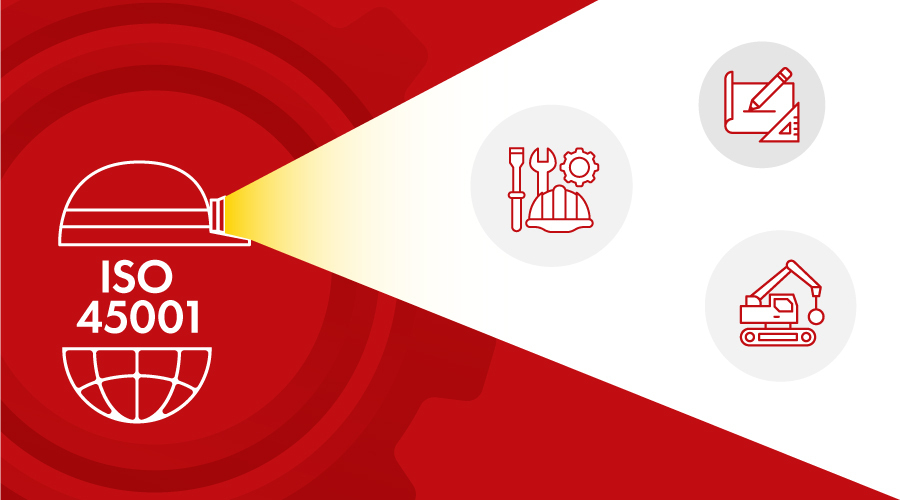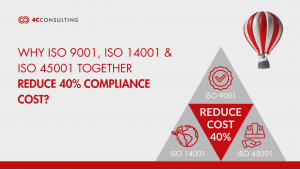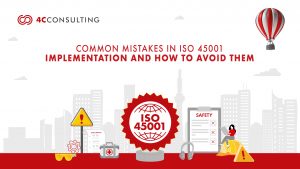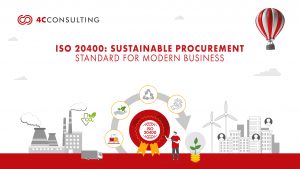WHAT IS ISO 45001: ITS REQUIREMENTS AND IMPLEMENTATION BENEFITS
16th Jul, 2025“Every worker deserves to return home safe and every organization has a role in making that happen.”
Across industries, ensuring employee health and safety has evolved from a legal formality into a strategic business priority. With over 2.78 million work-related deaths and 374 million non-fatal injuries each year, the human cost is undeniable—and so is the financial impact, with billions lost in compensation claims, medical expenses, and productivity. ISO 45001: 2015 standards offer a globally recognized framework to reverse this trend, helping organizations proactively manage risks, improve workplace conditions, and embed safety into their culture and operations. Unlike reactive approaches, ISO 45001 certification emphasizes prevention and accountability, ensuring safety isn’t just managed—it’s integrated. This blog explores what, why it matters, and how to implement it effectively for long-term business resilience.
.
OVERVIEW OF ISO 45001:
ISO 45001 certification is the internationally recognized standard for occupational health and safety (OH&S) management systems, published in 2018 to replace the previous OHSAS 18001 standard. This comprehensive framework provides organizations with a structured approach to proactively improve employee safety, reduce workplace risks, and create better working conditions across all industries and organization sizes.
This framework operates on the principle of risk-based thinking, enabling organizations to identify potential hazards before they cause harm rather than simply reacting to incidents after they occur. It’s designed to be flexible and adaptable, making it suitable for organizations ranging from small businesses to multinational corporations, regardless of their industry sector or geographical location.
.
Implement ISO 45001 for Safer Workplaces.
.
KEY ELEMENTS OF ISO 45001:
- Risk-Based Approach: ISO 45001 promotes proactive risk identification and control before incidents occur. Organizations must assess all activities—from routine tasks to emergencies—and implement preventive controls. This ensures hazards are addressed before they become accidents.
- Worker Participation: The standard requires involving workers in safety decisions, risk assessments, and investigations. Employees must be empowered to speak up without fear. Their first-hand insights are key to identifying practical and effective safety improvements.
- Leadership Commitment: Top management must lead by example, providing resources, setting objectives, and driving the OH&S culture. Active leadership involvement is essential to embed safety into every level of the organization and ensure system effectiveness.
- Continual Improvement: Organizations are expected to track performance, review data, and learn from incidents. Regular audits, reviews, and corrective actions help enhance safety. This keeps the OH&S system responsive and aligned with evolving risks.
- Integration Capability: ISO 45001 standards shares a structure with ISO 9001 and ISO 14001, making integration easy. Businesses can align systems, reduce duplication, and streamline audits—creating a unified approach to quality, environment, and safety.
.
WHY ISO 45001 CERTIFICATION IS IMPORTANT?
The importance of ISO 45001 extends beyond just meeting legal obligations. It plays a vital role in improving employee safety, reducing workplace risks, and enhancing overall business performance. With alarming statistics from the ILO showing over 2.78 million work-related deaths annually and $3 trillion in global economic losses, organizations must adopt structured safety systems. ISO 45001 offers a globally recognized framework to manage occupational health and safety (OH&S) risks proactively, protect workers, and strengthen stakeholder trust.
- Compliance Requirements: This standard helps organizations meet complex and evolving health and safety regulations. It reduces the risk of legal violations and financial penalties while ensuring adherence to both local and international standards. Compliance also reflects an organization’s ethical commitment to protecting its workforce.
- Due Diligence in Legal Matters: The standard supports legal defensibility by providing documented proof of a structured safety system. In case of accidents or audits, ISO 45001 certification documents demonstrates that an organization has taken reasonable and systematic steps to ensure worker safety—fulfilling its duty of care.
- Risk Mitigation & Prevention: ISO 45001 policy emphasizes early identification and control of hazards before they cause harm. By applying risk-based thinking, organizations can reduce workplace accidents, ensure business continuity, and minimize disruptions to operations. It promotes a proactive, rather than reactive, approach to safety.
- Improved Stakeholder Confidence: Certification sends a strong message to clients, investors, and partners about your organization’s commitment to workplace safety and responsible operations. It strengthens reputation, enhances market opportunities, and builds trust with both internal and external stakeholders.
.
WHO CAN IMPLEMENT ISO 45001?
It is a universally adaptable standard, designed to suit organizations of all sizes, sectors, and geographies. Its flexible framework allows each business to tailor the requirements to its unique operational context while upholding core principles of occupational health and safety. Whether it’s a small enterprise adopting streamlined processes or a global corporation managing complex, multi-site risks, ISO 45001 implementation offers a scalable structure. The standard acknowledges that every organization faces distinct hazards and challenges, enabling customized safety strategies within a consistent and internationally recognized system.
High-Risk Industries:
- Manufacturing and Heavy Industry: These sectors face high risks from machinery, chemicals, and manual processes. This standard helps to identify and control these hazards while involving workers directly. Its structured approach reduces injuries and boosts shop-floor efficiency. Implementation leads to safer operations and better productivity.
- Construction and Infrastructure: With risks like working at heights and dynamic site conditions, construction demands robust safety systems. ISO 45001 supports hazard identification, risk control, and coordination across projects. It enhances site safety and reduces insurance costs. The result is safer projects and improved client trust.
- Oil and Gas Operations: This high-risk industry faces threats from fire, toxic exposure, and environmental incidents. ISO 45001 documentation enables emergency preparedness and operational safety planning. Its focus on continual improvement strengthens compliance and public confidence. Adoption supports license retention and safer operations.
- Healthcare Facilities: Healthcare workers deal with biological, chemical, and ergonomic risks. This standard helps safeguard staff without compromising patient care quality. Staff input plays a key role in crafting effective safety measures. Results include fewer injuries, higher morale, and better service delivery.
Service-Based Organizations:
- Financial Services: Despite being low-risk physically, this sector faces mental health and ergonomic challenges. Implementing this in workplace aids in managing remote work, stress, and distributed teams. It helps standardize safety practices and support employee wellbeing. Benefits include reduced absenteeism and a healthier workplace culture.
- Educational Institutions: Schools and universities face lab, field, and campus safety risks. ISO 45001 training’s offers a unifying framework for managing diverse hazards. It aligns departmental efforts and enhances emergency readiness. The outcome is improved safety, compliance, and institutional reputation.
- Transportation and Logistics: Common risks include accidents, manual handling, and fatigue-related incidents. ISO 45001 internal audits helps implement fleet-wide safety systems and training. Continuous improvement boosts compliance and customer satisfaction. Implementation leads to safer operations and fewer workplace incidents.
Small and Medium Enterprises (SMEs):
- Small and Medium Enterprises (SMEs): SMEs can adopt certification gradually with basic safety systems that grow over time. The standard’s flexibility allows resource-constrained firms to build strong foundations. Even limited implementation reduces risks and boosts employee involvement. It makes safety achievable without overwhelming complexity.
- Competitive Advantage for SMEs: ISO 45001 certification standards builds trust with clients and opens doors to new contracts. Many buyers now require formal safety systems as part of procurement. Certification enhances credibility and workforce retention. SMEs gain both recognition and access to broader market opportunities.
.
KEY ISO 45001 REQUIREMENTS:
This certification requires organizations to establish and maintain comprehensive documentation that supports effective OH&S management while avoiding excessive bureaucracy. The standard emphasizes the importance of documented information that is useful, accessible, and regularly updated to reflect current practices and requirements.
- Health & Safety Policy: Organizations must define a clear OH&S policy that reflects their commitment to preventing injury and ill health. It should align with the organization’s context, address risks and opportunities, and include commitments to hazard elimination, risk reduction, continual improvement, and worker participation. The policy must be communicated and documented for all stakeholders.
- Objectives and Targets: Measurable OH&S objectives must be set at appropriate levels, aligned with the policy and legal requirements. They should reflect risks, opportunities, and available resources, with clear targets, timelines, responsibilities, and tracking methods. Progress must be monitored and communicated internally.
- Scope Definition: The OH&S management system’s scope must clearly define boundaries, activities, and applicability. It should consider internal/external factors, stakeholder needs, and operational control. The scope must be documented and regularly reviewed for continued relevance and completeness.
- HIRA (Hazard Identification & Risk Assessment): Organizations need systematic processes for identifying hazards and assessing risks across all activities, including emergencies and non-routine tasks. The process should factor in changes, incidents, and updated hazard knowledge, ensuring controls are adequate and risks are effectively managed.
- Records & Operational Controls: Records must demonstrate compliance and system effectiveness. Operational controls—such as engineering solutions, administrative procedures, and PPE—must be integrated into business processes. Regular ISO 45001 Gap analysis and monitoring ensures controls stay relevant, effective, and aligned with OH&S goals.
.
STEP TO IMPLEMENT ISO 45001 STANDARD:
A structured and phased approach is essential for implementing ISO 45001 effectively. The following stages outline the systematic route followed to align occupational health and safety practices with the standard’s requirements, while promoting long-term operational improvement, compliance, and certification readiness.
- Gap Analysis: The process begins with a comprehensive assessment of the organization’s existing health and safety practices, policies, and risk controls. Department-wise gaps are identified in line with standards requirements. This ISO 45001 Gap analysis forms the foundation for a clear implementation plan and prioritizes areas that need to be strengthened for certification.
- Awareness Training: ISO 45001Awareness training programs are conducted for the Committee and Core Team to introduce the core elements of standards. These sessions cover the standard overview, certification roadmap, and key observations from the gap analysis. Training ensures that relevant stakeholders are informed, aligned, and prepared to support implementation activities.
- Documentation: Essential documentation is developed to meet the requirements including the OH&S policy, objectives, risk assessments, procedures, and records. This documentation acts as a foundation for system implementation and provides evidence of conformity during ISO 45001 internal and external audits.
- Implementation & Monitoring: The documented system is implemented across departments with function-specific guidance. Regular monitoring is carried out to ensure practical application of procedures and to identify any operational deviations. This step transforms documentation into real-time workplace practices aligned with ISO 45001 implementation goals.
- Internal Auditor Training: A dedicated internal audit team is trained to assess compliance with ISO 45001 requirements and evaluate system effectiveness. The training enables cross-functional teams to conduct internal audits, detect non-conformities, and initiate corrective actions essential for maintaining certification and driving continuous improvement.
- Management Review: The management review process evaluates system performance, training effectiveness, audit results, and achievement of occupational health and safety objectives. Top management assesses whether the system is aligned with organizational goals and regulatory requirements, and makes informed decisions for improvement.
- Registration Audit: Coordination is established with the certification body to conduct Stage 1 and Stage 2 audits. During this phase the organization’s OH&S system is evaluated against the requirements. Findings are addressed, and successful closure leads to certification.
- System Value Management: After certification, periodic reviews, internal audits, training refreshers, and document updates are conducted to ensure system sustainability. This step focuses on maintaining compliance, improving OH&S performance, and preparing for surveillance audits as per the certification cycle.
.
BENEFITS OF IMPLEMENTATION ISO 45001:
Implementing ISO 45001 delivers immediate, measurable benefits that go beyond compliance, enhancing safety performance, operational efficiency, and employee engagement. Within the first year, organizations often see fewer incidents, lower costs, and stronger hazard control. As the system matures, it shifts safety management from reactive to proactive, enabling better risk prevention and supporting long-term business success through safer, more efficient operations.
- Competence Development: ISO 45001 requires organizations to establish comprehensive competency development programs that ensure all personnel have the knowledge, skills, and abilities necessary to perform their duties safely and effectively. This includes initial training for new employees, ongoing development for existing staff, and specialized training for high-risk activities or emergency situations. Competency development programs must be based on systematic needs assessment and regularly evaluated for effectiveness. Organizations typically see improved employee performance, reduced human error, and enhanced safety culture as a result of these programs.
- Emergency Preparedness: ISO 45001 requires organizations to develop comprehensive emergency response procedures that address potential emergency situations that could impact workplace safety and health. Emergency preparedness includes hazard-specific response procedures, communication protocols, evacuation plans, and coordination with external emergency services. Organizations must conduct regular drills and exercises to test their iso 45001 emergency response capabilities and make improvements based on lessons learned. Enhanced emergency preparedness typically reduces the severity of incidents when they do occur and improves organizational resilience.
- Risk Identification & Legal Compliance: ISO 45001 checklist provides organizations with systematic processes for identifying and managing all types of OH&S risks, from obvious physical hazards to subtle psychosocial risks that can impact employee wellbeing. The standard requires comprehensive risk assessment methodologies that consider all aspects of work activities, including routine operations, maintenance activities, and emergency situations. Legal compliance is enhanced through systematic processes for identifying, accessing, and monitoring applicable legal requirements. Organizations typically achieve better regulatory compliance, reduced legal exposure, and improved relationships with regulatory authorities.
- Integration with ISO 9001 & ISO 14001: ISO 45001 framework follows the same high-level structure as ISO 9001 (Quality Management) and ISO 14001 (Environmental Management), facilitating integration of management systems and creating operational synergies. Integrated management systems reduce duplication of effort, streamline audit processes, and create cost efficiencies. Organizations can leverage shared resources, documentation, and processes to maximize the effectiveness of all management systems. Integration typically results in improved overall performance, reduced management complexity, and enhanced stakeholder confidence.
- Monitoring & Continuous Improvement: The standard requires organizations to establish systematic and regular ISO 45001 Internal audits for monitoring OH&S performance and driving continuous improvement through data analysis and corrective action. Monitoring activities include both leading indicators (safety inspections, near-miss reporting) and lagging indicators (injury rates, incident costs). Organizations must analyze trends, identify root causes, and implement corrective actions to address deficiencies. This systematic approach to improvement typically results in year-over-year improvements in safety performance and operational efficiency.
- Better Stakeholder Confidence: ISO 45001 certification provides credible evidence of an organization’s commitment to employee safety and social responsibility, enhancing confidence among customers, investors, employees, and regulatory authorities. Stakeholder confidence is particularly important in today’s business environment where social responsibility and environmental, social, and governance (ESG) factors increasingly influence business decisions. Organizations with certified OH&S management systems often experience improved customer relationships, easier access to capital, and enhanced reputation in their industries.
- Enhanced Reputation: ISO 45001 certification provides organizations with a competitive differentiator that demonstrates commitment to employee safety and social responsibility. Enhanced reputation can lead to improved customer relationships, easier access to new markets, and increased ability to attract and retain quality employees. Reputation benefits are particularly important in industries where safety performance is closely scrutinized by stakeholders. Organizations often find that their certification becomes a valuable marketing tool that sets them apart from competitors.
- Competitive Advantage: Many customers and partners require evidence of systematic safety management as a prerequisite for doing business. This certification can provide access to new markets, tender opportunities, and partnership arrangements that would not be available otherwise. Competitive advantage is also enhanced through improved operational efficiency, reduced costs, and enhanced employee engagement. Organizations with certified OH&S management systems often outperform their peers in terms of safety performance, operational efficiency and employee satisfaction.
.
HOW 4C CONSULTING CAN HELP YOU IMPLEMENT ISO 45001?
Partnering with 4C Consulting ensures a smooth and effective ISO 45001 compliance tailored to your industry and organizational needs. With over 18+ years of experience, 10,000+ OH&S training hours, and 50+ successful workshops, our expert consultants guide you through every stage—from gap analysis to certification. 4C’s ISO 45001 Consultants take a customized approach to address your unique challenges, helping you move beyond compliance to build a sustainable, high-impact safety management system that enhances performance, reduces risks, and creates lasting value for your people and business. Book your free 1-hour ISO 45001 consultation now.

Frequently Asked Questions:
ISO 45001:2018 is an international standard that provides a framework for managing occupational health and safety (OH&S). It helps organizations create safer workplaces, reduce risks, and prevent work-related injuries and illnesses through a structured, proactive approach.
The standard focuses on identifying and managing workplace risks, involving workers in safety decisions, and continuously improving safety performance. It emphasizes leadership, worker participation, and integrating safety into overall business processes—not just following rules, but building a strong safety culture.
As of now, ISO 45001:2018 is the current official version. While some guidance documents or interpretations may have been updated in 2023, no formal revision of the standard itself has been published. Always refer to the ISO website or your certification body for the most current updates.
HIRA stands for Hazard Identification and Risk Assessment, a core requirement of ISO 45001:2018. It involves spotting potential workplace hazards, evaluating risks, and implementing control measures. HIRA forms the foundation of an effective safety system, guiding decisions on training, controls, and emergency readiness.
Key requirements include setting a safety policy, identifying hazards (HIRA), complying with legal rules, training staff, managing emergencies, auditing systems, and involving leadership and workers. Everything must be documented, monitored, and continuously improved.
ISO 45001 replaced OHSAS 18001 in 2018. It includes stronger leadership involvement, better integration with ISO 9001 and 14001, and a focus on worker participation and organizational context. The shift was made to align safety with modern management practices.






